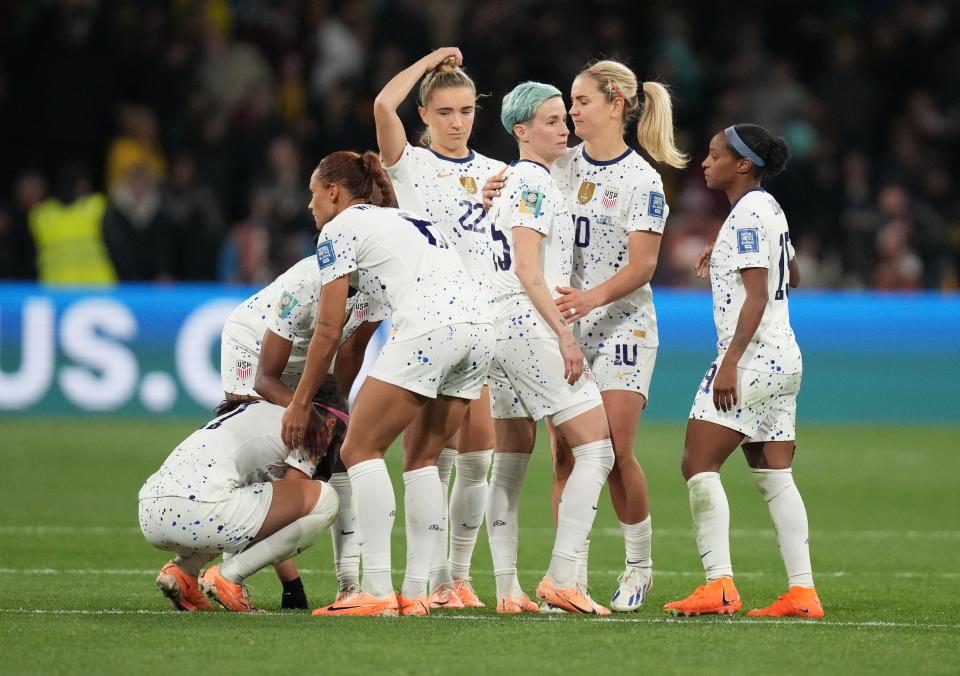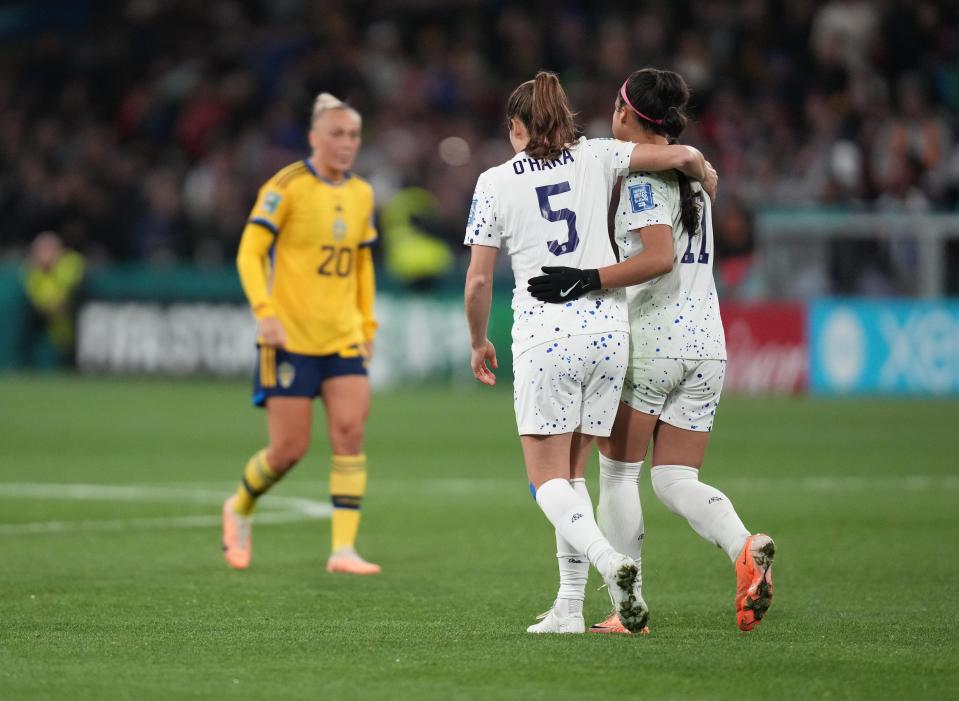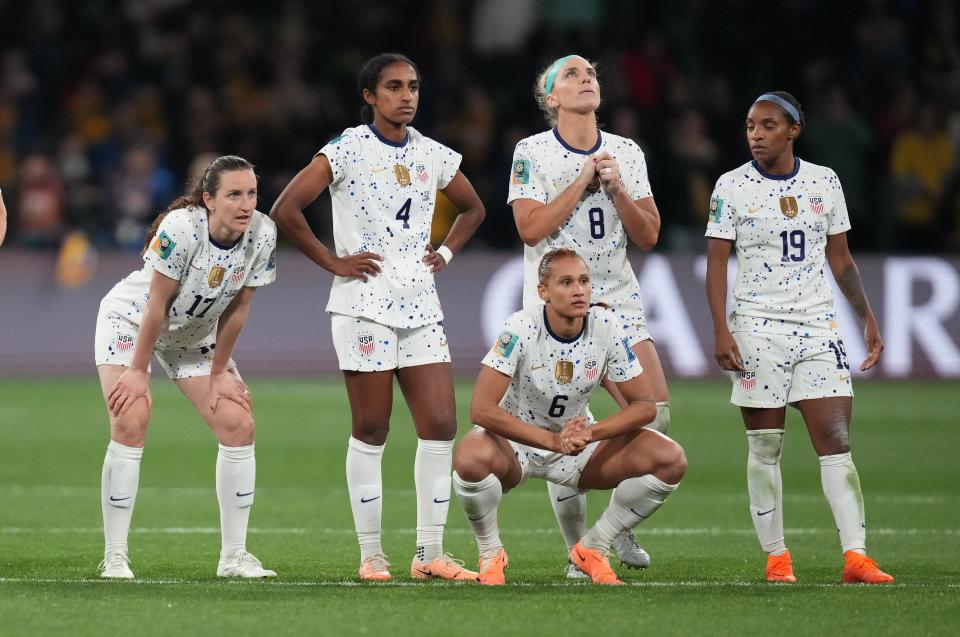Arace: The USWNT was a major disappointment at the World Cup, but they'll bounce back

One cannot separate sport from politics when it comes to the United States Women’s National Team, which is fine with the players. On and off the field, the U.S. women are a beacon to the world. If that means a chunk of their fellow American citizens celebrate their losses – which happened in a whip snap after the USWNT was eliminated from the World Cup – well, the arc of history still needs more bend in it, and they'll keep torquing.
The loss to Sweden on penalty kicks was a soaring disappointment for them, their legions of fans and the USSF. The national team did not play well in this tournament – that is, until the knockout stage, when their attacking game was finally unleashed. The problem for the young U.S. team was threefold: They lacked their trademark ruthless finish; their opponent, No. 3 in FIFA’s world rankings, was its typically resilient self, and its goalkeeper was spectacular; the shootout was a U.S. disaster.
The dream of a three-peat met an ugly end in the Round of 16. It’s natural to wonder how this could happen to the U.S., which still has the biggest and best pipeline of women’s talent in the world. The federation has to take some blame and figure out what it can fix. Will coach Vlatko Andonovski get sacked? Sometimes, that’s the way it goes with high-stakes games.
The U.S. won five of the previous eight World Cups and four of the seven Olympic tournaments. Is 2023 the year that the American hegemony on women’s soccer is dashed? If so, it is a credit to generations of American athletes. They made it happen.

The USWNT is among sport’s greatest forces for positive change in my lifetime. They are Tommie Smith and John Carlos with their fists raised on the medal platform in 1968, Muhammad Ali in exile, Billie Jean King with a cause, Serena Williams from Compton. Women of all ages, everywhere, understand as much.
When an American journalist suggested, in the aftermath of the loss to Sweden, that the USWNT reign is “over,” Swedish midfielder Kosovare Aslani lashed out in her response:
“I was like, ‘Don’t talk (smack) about the American team,’ ” Aslani said on the Re-Cap Show podcast. “The U.S. Women’s National Team, they’re pioneers. I mean, you are raising the game. You are opening doors for the rest of the community, the rest of the world. You are first with everything. … They will come back for sure. They have so much quality on their team. This defeat will not take them down.”
The USWNT was created in 1985 primarily because the national federation found that funding the team was cheaper than losing a lawsuit. The first USWNT players were not paid, but they got $10 a day for food. The first women’s World Cup in 1991 was called the “M&M’s Cup” because FIFA, the global governing body, didn't know who else to bribe.
Title IX gave the Americans a jump. They won the ‘91 M&Ms Cup, played in China. Eight years later, Brandi Chastain pierced the consciousness of the nation with her Cup-winning goal. In between there was another launching pad – in 1996, when women's soccer was introduced to the Olympic Games in Atlanta. The USWNT earned gold.

Prior to the Atlanta Games, USWNT players staged a strike to put pressure on the federation to increase their medal bonuses. That sort of “good trouble,” which is what civil rights activist and congressman John Lewis called the fight for justice and equality, was in the DNA of the players who got the program off the ground in the 1980s. They wanted to be a voice for all the voiceless women and girls. It remains a hallmark.
It was not lost on the USWNT players that their victory over Japan in the 2015 WWC final remains the most watched soccer match involving a U.S. team in American broadcast history, with an average of 23 million viewers. The American women began fighting U.S. Soccer over gender discrimination beginning in 2016 and, in 2022, after a series of court victories, they collectively bargained a contract that assures that they and the U.S. men’s team are paid equally.
Because of Title IX, our country has led the world into a new age, one where women can aspire in team sports, and even sweat. The USWNT has been particularly impactful because they have accelerated the women’s movement in the world’s most popular sport. Part and parcel of this movement is the fight against gender discrimination. This fight has at times included activism in the field of LGBTQ+ rights, and standing (kneeling, actually) with Black Lives Matter. So it was that those who once jeered Colin Kaepernick, calling him un-American, lustily cheered against America, last week.
It may be that the USWNT will never reach the peak of power they achieved when they completed their WWC back-to-back in 2019. The thing is, the U.S. has always had its worthy rivals over the years – in fact, Germany won a back-to-back Cups before the U.S. did. Now, though, there are more rivals than ever.
Our women set out to inspire the world to beat them, and here comes the world. Presently, the U.S. women are now more feared by the Americans who root against them than by their international rivals, but they’ll be back. Count on it. Because if there's one thing they've never lacked, it is courage.
This article originally appeared on The Columbus Dispatch: The USWNT urged the world to catch up to them, and so it has happened
